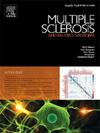荷兰多发性硬化症的患病率和发病率。
IF 2.9
3区 医学
Q2 CLINICAL NEUROLOGY
引用次数: 0
摘要
背景:全球多发性硬化症(MS)的患病率估计不断上升,强调了荷兰最新流行病学数据的必要性。方法:结合来自两个荷兰医疗数据库(Nivel初级保健数据库和Vektis数据库)的数据,包括2019年的全科医生和医院电子健康记录,以评估年龄和性别标准化的MS患病率和发病率。研究了基于纬度和初级与二级保健记录的患病率估计差异。结果:年龄和性别标准化患病率估计为每10万居民210.4人。2019年MS的发病率估计为每10万人年7.1例。三分之一来自初级保健记录的MS队列连续两年没有在医院数据库中记录。北部地区的患病率估计高于南部地区(分别为每10万居民240.6人和208.3人)。结论:与全球不同地区的结果一致,荷兰MS的患病率估计在过去十年中显着增加,而发病率估计则保持稳定。初级和二级医疗机构中多发性硬化症记录的差异可能表明,荷兰有相当比例的多发性硬化症患者没有接受专门的神经系统护理。本文章由计算机程序翻译,如有差异,请以英文原文为准。
Prevalence and incidence of multiple sclerosis in the Netherlands
Background
The rising prevalence estimates of multiple sclerosis (MS) globally underscore the imperative for up-to-date epidemiological data specific to the Netherlands.
Methods
Data from two Dutch healthcare databases (Nivel Primary Care Database and Vektis Database) comprising both general practices and hospital electronic health records in 2019 were combined to assess age- and sex-standardized MS prevalence and incidence estimates. Differences in prevalence estimates based on latitude and between primary versus secondary care records were examined.
Results
The age and sex-standardized prevalence estimate was 210.4 per 100,000 inhabitants. Incidence estimate of MS was 7.1 per 100,000 person-years within the year 2019. One-third of the MS cohort from primary care records was not documented in the hospital database over two consecutive years. Prevalence estimates were higher in northern areas versus southern areas (respectively 240.6 versus 208.3 per 100,000 inhabitants).
Conclusion
Aligning results from different global regions, prevalence estimates of MS in the Netherlands have increased significantly over the last decennia, while incidence estimates are stable. The discrepancy between MS records within the primary and secondary care setting could indicate that a substantial proportion of Dutch patients with MS are not under specialized neurological care.
求助全文
通过发布文献求助,成功后即可免费获取论文全文。
去求助
来源期刊

Multiple sclerosis and related disorders
CLINICAL NEUROLOGY-
CiteScore
5.80
自引率
20.00%
发文量
814
审稿时长
66 days
期刊介绍:
Multiple Sclerosis is an area of ever expanding research and escalating publications. Multiple Sclerosis and Related Disorders is a wide ranging international journal supported by key researchers from all neuroscience domains that focus on MS and associated disease of the central nervous system. The primary aim of this new journal is the rapid publication of high quality original research in the field. Important secondary aims will be timely updates and editorials on important scientific and clinical care advances, controversies in the field, and invited opinion articles from current thought leaders on topical issues. One section of the journal will focus on teaching, written to enhance the practice of community and academic neurologists involved in the care of MS patients. Summaries of key articles written for a lay audience will be provided as an on-line resource.
A team of four chief editors is supported by leading section editors who will commission and appraise original and review articles concerning: clinical neurology, neuroimaging, neuropathology, neuroepidemiology, therapeutics, genetics / transcriptomics, experimental models, neuroimmunology, biomarkers, neuropsychology, neurorehabilitation, measurement scales, teaching, neuroethics and lay communication.
 求助内容:
求助内容: 应助结果提醒方式:
应助结果提醒方式:


